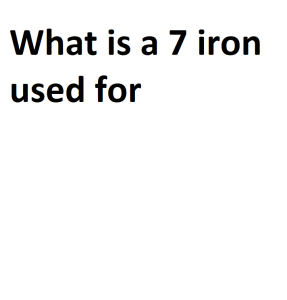The 7 iron is one of the many clubs in a golfer’s arsenal, and it serves a specific purpose within the game. In this article, we will explore what a 7 iron is used for and delve into the details of its design, characteristics, and how it fits into a golfer’s strategy.
Understanding the 7 Iron
Club Design and Characteristics
- The 7 iron is part of the iron club category, distinguished by their solid clubheads and relatively shorter shafts compared to woods.
- It has a loft angle that typically ranges between 30 to 34 degrees, making it more lofted than lower-numbered irons but less so than higher-numbered ones.
- The clubhead is relatively small, with a thinner face designed for accuracy and control.
- The shaft of the 7 iron is usually made of steel or graphite, and its length falls between that of longer woods and shorter irons.
Distance and Trajectory
- The 7 iron is known for its versatility, offering a balance between distance and trajectory.
- On average, a well-struck 7 iron can cover a distance of approximately 150 to 170 yards for male golfers and 120 to 140 yards for female golfers.
- The loft angle of the 7 iron generates a moderate height trajectory, making it useful for navigating obstacles such as trees or bunkers while maintaining good distance control.
When to Use a 7 Iron
Approach Shots
- The 7 iron is commonly used for approach shots to the green. Its loft allows for precision in controlling the ball’s height and distance.
- Golfers often choose the 7 iron when they are in the fairway, aiming to reach the green with accuracy and avoid overshooting.
Challenging Lies
- When golfers find themselves in challenging lies, such as rough or light rough, the 7 iron can be a dependable choice. Its loft helps lift the ball cleanly from these conditions.
Par-3 Holes
- Par-3 holes, which are shorter and require accurate tee shots, are ideal situations for using a 7 iron. The club provides good control over the distance needed to reach the green.
Advanced Techniques with the 7 Iron
Shot Shaping
- Skilled golfers often use the 7 iron for shot shaping, manipulating the ball’s flight path. Draw and fade shots are achievable with proper technique and clubface control.
Bump-and-Run
- In certain situations where golfers need to keep the ball low and rolling along the ground, a 7 iron can be employed for a bump-and-run shot. This technique is useful for avoiding obstacles near the green.
Selecting the Right 7 Iron
Club Selection
- Golfers often have the option to customize their club set, and this includes the 7 iron. Different manufacturers and models offer variations in terms of clubhead design, shaft material, and club length.
- When selecting a 7 iron, it’s important to consider personal preferences, swing characteristics, and the specific course conditions you frequently encounter. Try out different options to find the 7 iron that best suits your game.
Practicing with the 7 Iron
Swing Practice
- As with any golf club, consistent practice with the 7 iron is crucial for improving your game. Spend time on the driving range honing your swing and distance control with this club.
- Practice different shot types, including straight shots, fades, and draws, to become more versatile with the 7 iron.
Distance Control
- Developing a keen sense of distance control with the 7 iron is essential for precision on the course. Use various drills and markers on the range to fine-tune your ability to hit specific yardages.
Conclusion
The 7 iron is a versatile and valuable club in a golfer’s bag, offering a balanced combination of distance, trajectory, and control. By understanding its design, purpose, and when to use it effectively, golfers can optimize their performance and take steps toward improving their overall game. Regular practice and customization of your 7 iron selection can further enhance your golfing experience and results on the course.


